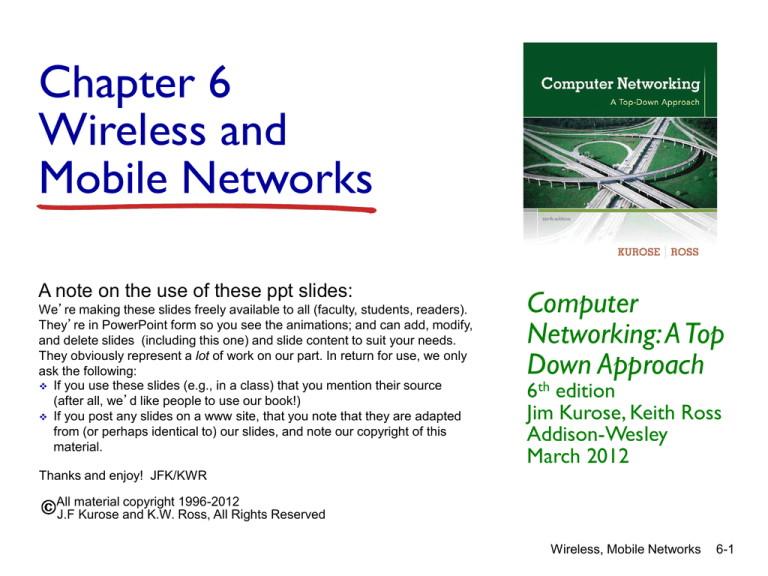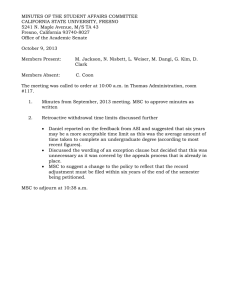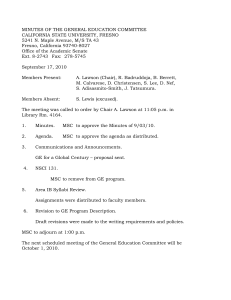
Chapter 6
Wireless and
Mobile Networks
A note on the use of these ppt slides:
We’re making these slides freely available to all (faculty, students, readers).
They’re in PowerPoint form so you see the animations; and can add, modify,
and delete slides (including this one) and slide content to suit your needs.
They obviously represent a lot of work on our part. In return for use, we only
ask the following:
If you use these slides (e.g., in a class) that you mention their source
(after all, we’d like people to use our book!)
If you post any slides on a www site, that you note that they are adapted
from (or perhaps identical to) our slides, and note our copyright of this
material.
Computer
Networking: A Top
Down Approach
6th edition
Jim Kurose, Keith Ross
Addison-Wesley
March 2012
Thanks and enjoy! JFK/KWR
All material copyright 1996-2012
J.F Kurose and K.W. Ross, All Rights Reserved
Wireless, Mobile Networks
6-1
Components of cellular network architecture
recall:
correspondent
wired public
telephone
network
MSC
MSC
MSC
MSC
MSC
different cellular networks,
operated by different providers
Wireless, Mobile Networks
6-2
Handling mobility in cellular networks
home network: network of cellular provider you
subscribe to (e.g., Sprint PCS, Verizon)
home location register (HLR): database in home network
containing permanent cell phone #, profile information
(services, preferences, billing), information about
current location (could be in another network)
visited network: network in which mobile currently
resides
visitor location register (VLR): database with entry for
each user currently in network
could be home network
Wireless, Mobile Networks
6-3
GSM: indirect routing to mobile
home
network
HLR
2
home MSC consults HLR,
gets roaming number of
mobile in visited network
correspondent
home
Mobile
Switching
Center
1
3
VLR
Mobile
Switching
Center
4
Public
switched
telephone
network
call routed
to home network
home MSC sets up 2nd leg of call
to MSC in visited network
mobile
user
visited
network
MSC in visited network completes
call through base station to mobile
Wireless, Mobile Networks
6-4
GSM: handoff with common MSC
VLR Mobile
Switching
Center
old
routing
old BSS
handoff goal: route call via
new base station (without
interruption)
reasons for handoff:
stronger signal to/from new BSS
(continuing connectivity, less
battery drain)
load balance: free up channel in
current BSS
GSM doesnt mandate why to
perform handoff (policy), only
how (mechanism)
new
routing
new BSS
handoff initiated by old BSS
Wireless, Mobile Networks
6-5
GSM: handoff with common MSC
VLR Mobile
Switching
Center 2
4
1
8
old BSS
5
7
3
6
new BSS
1. old BSS informs MSC of impending
handoff, provides list of 1+ new BSSs
2. MSC sets up path (allocates resources)
to new BSS
3. new BSS allocates radio channel for
use by mobile
4. new BSS signals MSC, old BSS: ready
5. old BSS tells mobile: perform handoff to
new BSS
6. mobile, new BSS signal to activate new
channel
7. mobile signals via new BSS to MSC:
handoff complete. MSC reroutes call
8 MSC-old-BSS resources released
Wireless, Mobile Networks
6-6
GSM: handoff between MSCs
home network
correspondent
Home
MSC
anchor MSC
PSTN
MSC
MSC
MSC
anchor MSC: first MSC
visited during call
call remains routed
through anchor MSC
new MSCs add on to end of
MSC chain as mobile moves
to new MSC
optional path minimization
step to shorten multi-MSC
chain
(a) before handoff
Wireless, Mobile Networks
6-7
GSM: handoff between MSCs
home network
correspondent
Home
MSC
anchor MSC
PSTN
MSC
MSC
MSC
anchor MSC: first MSC
visited during call
call remains routed
through anchor MSC
new MSCs add on to end of
MSC chain as mobile moves
to new MSC
optional path minimization
step to shorten multi-MSC
chain
(b) after handoff
Wireless, Mobile Networks
6-8
I didn’t cover this in this class.
Mobility: GSM versus Mobile IP
GSM element
Comment on GSM element
Mobile IP element
Home system
Network to which mobile user’s permanent
phone number belongs
Home
network
Gateway Mobile
Switching Center, or
“home MSC”. Home
Location Register
(HLR)
Home MSC: point of contact to obtain routable
address of mobile user. HLR: database in
home system containing permanent phone
number, profile information, current location of
mobile user, subscription information
Home agent
Visited System
Network other than home system where
mobile user is currently residing
Visited
network
Visited Mobile
services Switching
Center.
Visitor Location
Record (VLR)
Visited MSC: responsible for setting up calls
to/from mobile nodes in cells associated with
MSC. VLR: temporary database entry in
visited system, containing subscription
information for each visiting mobile user
Foreign agent
Mobile Station
Roaming Number
(MSRN), or “roaming
number”
Routable address for telephone call segment
between home MSC and visited MSC, visible
to neither the mobile nor the correspondent.
Care-ofaddress
Wireless, Mobile Networks
6-9
Chapter 6 summary
Wireless
wireless links:
Mobility
capacity, distance
channel impairments
CDMA
home, visited networks
direct, indirect routing
care-of-addresses
IEEE 802.11 (“Wi-Fi”)
CSMA/CA reflects wireless
channel characteristics
case studies
mobile IP
mobility in GSM
cellular access
architecture
standards (e.g., GSM, 3G,
4G LTE)
principles: addressing,
routing to mobile users
impact on higher-layer
protocols
Wireless, Mobile Networks 6-10




